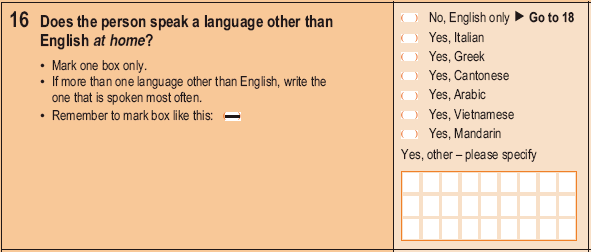MAIN LANGUAGE OTHER THAN ENGLISH SPOKEN AT HOME / PROFICIENCY IN SPOKEN ENGLISH
JUSTIFICATION
Questions on language use are important for a wide range of policies at the national, state and territory, and local levels. The Government's access and equity policies require language use data to be available for monitoring and implementing associated programs.
HISTORICAL INFORMATION
A language question was first included in 1921, asking whether the person could read and write. In 1933, the question asked whether the person could read and write a foreign language if unable to read and write English. Language was not included again until 1976, when a question on languages regularly used was included.
A question on language has been asked for each Census since the 1986 Census. Response categories included in the question are the most common languages spoken at home reported in the previous Census. Respondents are able to provide their language if it is not included in the list of response categories.
In the lead-up to the 2006 Census, the ABS considered reformatting the language question to collect data on English and Other only, with Other being unspecified. An investigation on the modelling of language data was undertaken, using responses from related ethnicity questions from both 1996 and 2001 Censuses. The results showed sufficient quality outcomes for a range of languages at the statistical local area level.
However, the investigation also showed that some areas of the language classification would experience high levels of either over, or under, estimation of populations if modelling was relied upon for the derivation of language data. This was especially true for Indigenous languages. Consequently, the 2006 Census language question remained in the same format as that used in the 2001 Census.
In 1981, a question was asked on proficiency in spoken English for those persons speaking a language other than English at home. A similar question has been asked on each Australian Census since 1981.
USER REQUIREMENTS
Data on languages are required:
- for the investigation and development of language services such as interpreter/translation and education
- for the implementation of national and state and territory language policies
- as an indicator of ‘active’ ethnicity.
Language, either alone or in combination with other characteristics, is a useful adjunct to other ethnicity related variables.
Data on proficiency in English are needed for:
- the development of English teaching programs
- the development of multilingual information programs
- the provision of interpretation/translation services
- the provision of migrant welfare or community services
- a measure of successful participation in the broader Australian community.
Data on languages spoken are required at small area level and for small population groups for the planning and delivery of the services above.
AVAILABILITY OF NON-CENSUS DATA
A number of ABS surveys collect data on the main language other than English spoken at home.
The Census is the only source of data on proficiency in spoken English.
2006 CENSUS QUESTIONS

Response categories included in the language question reflect the languages most commonly spoken at home as reported in the previous Census, except for Mandarin. Mandarin has been included to cover the main Chinese dialects and avoid distortion due to speakers of Mandarin opting for Cantonese in the belief that it is the only Chinese dialect available.

 Print Page
Print Page
 Print All
Print All